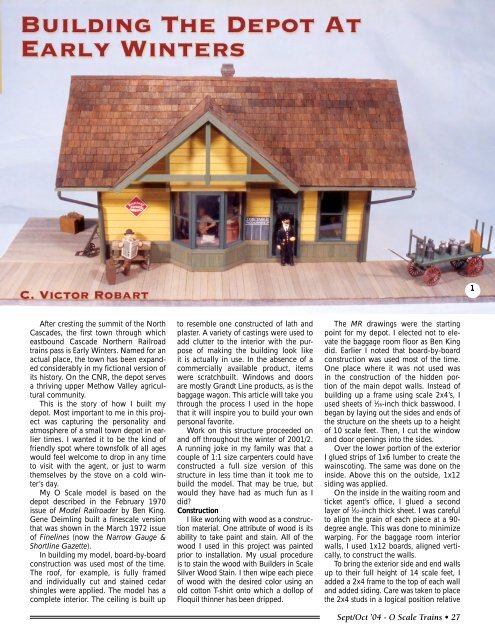US $5.95 • Can $7.95 - O scale trains
US $5.95 • Can $7.95 - O scale trains
US $5.95 • Can $7.95 - O scale trains
Create successful ePaper yourself
Turn your PDF publications into a flip-book with our unique Google optimized e-Paper software.
1After cresting the summit of the NorthCascades, the first town through whicheastbound Cascade Northern Railroad<strong>trains</strong> pass is Early Winters. Named for anactual place, the town has been expandedconsiderably in my fictional version ofits history. On the CNR, the depot servesa thriving upper Methow Valley agriculturalcommunity.This is the story of how I built mydepot. Most important to me in this projectwas capturing the personality andatmosphere of a small town depot in earliertimes. I wanted it to be the kind offriendly spot where townsfolk of all ageswould feel welcome to drop in any timeto visit with the agent, or just to warmthemselves by the stove on a cold winter’sday.My O Scale model is based on thedepot described in the February 1970issue of Model Railroader by Ben King.Gene Deimling built a fine<strong>scale</strong> versionthat was shown in the March 1972 issueof Finelines (now the Narrow Gauge &Shortline Gazette).In building my model, board-by-boardconstruction was used most of the time.The roof, for example, is fully framedand individually cut and stained cedarshingles were applied. The model has acomplete interior. The ceiling is built upto resemble one constructed of lath andplaster. A variety of castings were used toadd clutter to the interior with the purposeof making the building look likeit is actually in use. In the absence of acommercially available product, itemswere scratchbuilt. Windows and doorsare mostly Grandt Line products, as is thebaggage wagon. This article will take youthrough the process I used in the hopethat it will inspire you to build your ownpersonal favorite.Work on this structure proceeded onand off throughout the winter of 2001/2.A running joke in my family was that acouple of 1:1 size carpenters could haveconstructed a full size version of thisstructure in less time than it took me tobuild the model. That may be true, butwould they have had as much fun as Idid?ConstructionI like working with wood as a constructionmaterial. One attribute of wood is itsability to take paint and stain. All of thewood I used in this project was paintedprior to installation. My usual procedureis to stain the wood with Builders in ScaleSilver Wood Stain. I then wipe each pieceof wood with the desired color using anold cotton T-shirt onto which a dollop ofFloquil thinner has been dripped.The MR drawings were the startingpoint for my depot. I elected not to elevatethe baggage room floor as Ben Kingdid. Earlier I noted that board-by-boardconstruction was used most of the time.One place where it was not used wasin the construction of the hidden portionof the main depot walls. Instead ofbuilding up a frame using <strong>scale</strong> 2x4’s, Iused sheets of 1 ⁄16-inch thick basswood. Ibegan by laying out the sides and ends ofthe structure on the sheets up to a heightof 10 <strong>scale</strong> feet. Then, I cut the windowand door openings into the sides.Over the lower portion of the exteriorI glued strips of 1x6 lumber to create thewainscoting. The same was done on theinside. Above this on the outside, 1x12siding was applied.On the inside in the waiting room andticket agent’s office, I glued a secondlayer of 1 ⁄32-inch thick sheet. I was carefulto align the grain of each piece at a 90-degree angle. This was done to minimizewarping. For the baggage room interiorwalls, I used 1x12 boards, aligned vertically,to construct the walls.To bring the exterior side and end wallsup to their full height of 14 <strong>scale</strong> feet, Iadded a 2x4 frame to the top of each walland added siding. Care was taken to placethe 2x4 studs in a logical position relativeSept/Oct ’04 - O Scale Trains <strong>•</strong> 27
















